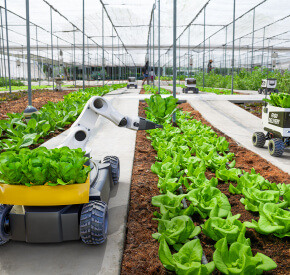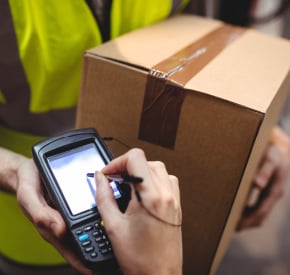
IoT keeps hard working industrial assets in first-rate condition
Saving time, money and resources for the companies that rely on them.
The growth of condition monitoring
The main aim of condition monitoring is to ensure the efficient functioning of industrial assets (machines, devices, equipment etc) that are performing critical tasks for a business. Over time these machines degrade or develop faults and therefore need to be regularly monitored and maintained.
Condition monitoring is the process of controlling specific parameters of a machine to detect issues before it leads to noticeable damage. Expensive and essential assets like wind turbines use condition monitoring to observe the rotating parts and bearings. By using sensors to track changes in the surrounding environment or over-usage for example, it’s possible to detect a potential failure. Using IoT, the sensors are able to rely information, so the necessary actions can be taken.

The growth of condition monitoring
As faults inevitably develop in machinery, even routine maintenance programs cannot effectively stop failures. This is where condition monitoring helps take the driving seat and prevent breakdowns.
It is estimated that 64% of the unplanned downtime is because of the equipment failure. Often it’s the most fragile components of a machine that need the most attention — rotating parts, engines, pumps etc. These are the elements that are likely to wear down fastest and are also the key parts of the machinery on which functionality depends the most. In any industry, where dealing with damage is more expensive than investing in managing it, condition monitoring is a must. IoT condition monitoring inevitably extends an assets life, thereby reducing overall capital expenditure.
Condition monitoring starts with basic inspections. Connected sensors can detect small changes, like abnormal heat or pressure, strange sounds, excessive vibration or a different smell, these are often the first signs that something is going haywire. Using predefined rules, sensors can alert you when assets are at risk so the appropriate action can be taken to avoid breakdowns or failures.
Decreases maintenance expenses
Condition monitoring eradicates the approach of fixing things as they break, and re-directs efforts to predictive maintenance based on smart analytics.
Maximises production output
Faulty machinery stalls the production process and reduces a team’s productivity and output. IoT based condition monitoring helps to avoid these work interruptions and increases production volumes.
Prolongs the lifespan of the equipment
Businesses don’t have to buy an entirely new machine just because it’s not functioning as it should. Instead, they can identify problematic areas in the existing ones and resolve.
Reduce expenditure
Many significant costs are incurred due to non-functioning assets. This includes losses in productivity, ad hoc costs to implement short-term fixes and repair assessments and repair expenses.

Why cellular connectivity for condition monitoring?
For global IoT deployments, cellular connectivity is widely considered the most logical and reliable connection option. There is no need to build new infrastructure nor add additional network gateways to support remote deployments. Connectivity is via the cell towers that are already in place.
The already tried and tested infrastructure, also provides the added benefit of cellular roaming. For solutions that may either be deployed to an unknown spot in the world or move frequently between regions, a cellular provider with multiple mobile network operators (MNOs) would be a sensible option.
Choice of bearer services
Cellular networks offer a range of connectivity options – 2G, 3G, LTE, 5G, LPWA. The right option will depend on the application and the functions it needs to provide. Smart meter connectivity tends to utilise a lower frequency like 2G or 3G. The data transmitted although frequent is fairly low bandwidth so a high bandwidth like 4G or 5G isn’t required. In some instances a low power wide area network maybe more suitable such as NB-IoT or LTE-M, especially for battery powered meters.
Other applications for condition monitoring, such as drone surveillance, will require a high bandwidth technology like 5G. Because a 5G network can carry massive amounts of data at lightning speeds over wide areas, the drone is able to send high quality images in real-time to the control centre.
Security
Cyber security risks are a reality. It is essential to keep the gateway secure and create private connections to the cloud. On-SIM technology and mobile core network services, resolves IoT device identity issues, enables dynamic scalability and provides defence against spoofing of IoT devices, ransomware events and unauthorised device access to network and cloud services.
Since cellular networks use SIM cards for authentication, it’s exceedingly difficult to spoof the identity of a device. SIMs can be pre-provisioned to securely communicate with Cloud Services. Compare this to Wi-Fi: When connected to a public Wi-Fi network, devices are sharing the connection with all other devices on the network. If any individual device has a security concern, all devices are at-risk. Cellular keeps every device separate from every other device, ensuring the security of the data being transmitted.
IoT connectivity solutions for any sector

Our IoT solutions enable precision farming, optimise resources and improve yields through data-driven decisions for smart, sustainable operations.

Our IoT solutions offer remote control, real-time monitoring and automation of wearables, home appliances and digital assets for enhanced convenience and security.

Our IoT solutions enable predictive maintenance, optimise distribution and support smart grids, enhancing reliability and sustainability whilst reducing costs.

Our IoT solutions offer critical data for environmental protection, regulatory compliance and sustainable resource management, fostering a healthier ecosystem.

Our IoT solutions enable real-time patient data, predictive maintenance of smart devices and better treatment outcomes for personalised healthcare.

Our IoT solutions improve efficiency, reduce downtime and enhance quality control, transforming operations into smart manufacturing processes.

Our IoT solutions optimise supply chains, reduce costs and improve delivery accuracy for better reliability and customer satisfaction.

Improve service delivery and operational efficiency with smart infrastructure, real-time data and automation for a safer, sustainable community.

Our IoT solutions optimise stock management, support sales strategies and provide a seamless, personalised shopping experiences.

Our IoT solutions offer comprehensive coverage, improve incident response and enable proactive threat detection, protecting people and assets.

Our IoT solutions optimise energy use, enhance occupant experience and reduce costs for sustainable, intelligent building environments.

Our IoT solutions enable local authorities to improve urban living, through real-time analytics, connected infrastructure and automated services.

Our IoT solutions reduce downtime, improve delivery services and boost customer satisfaction driving innovation and sustainability in transportation.
